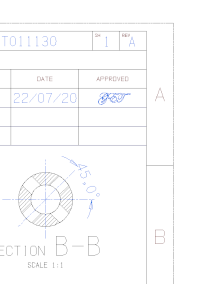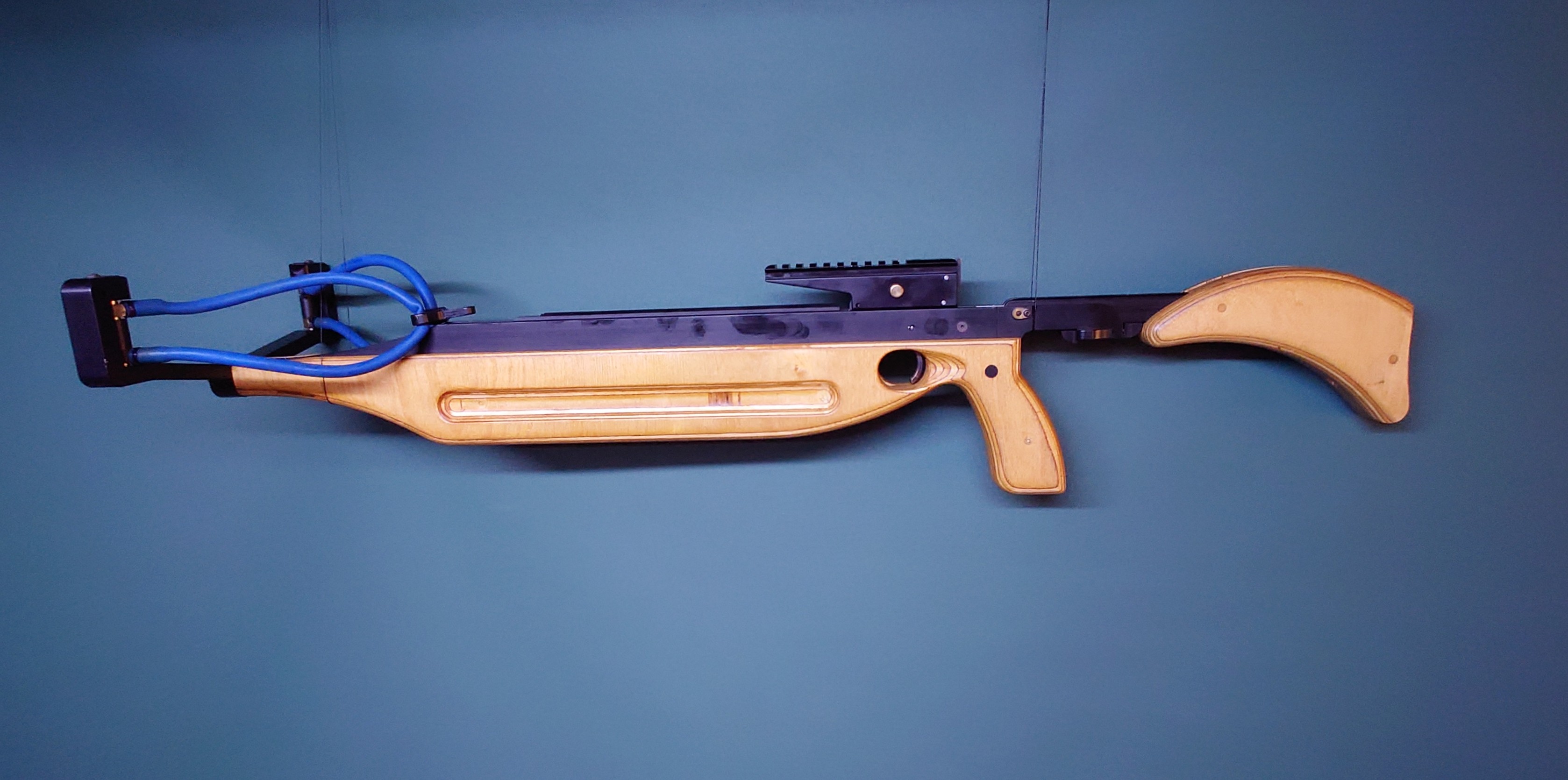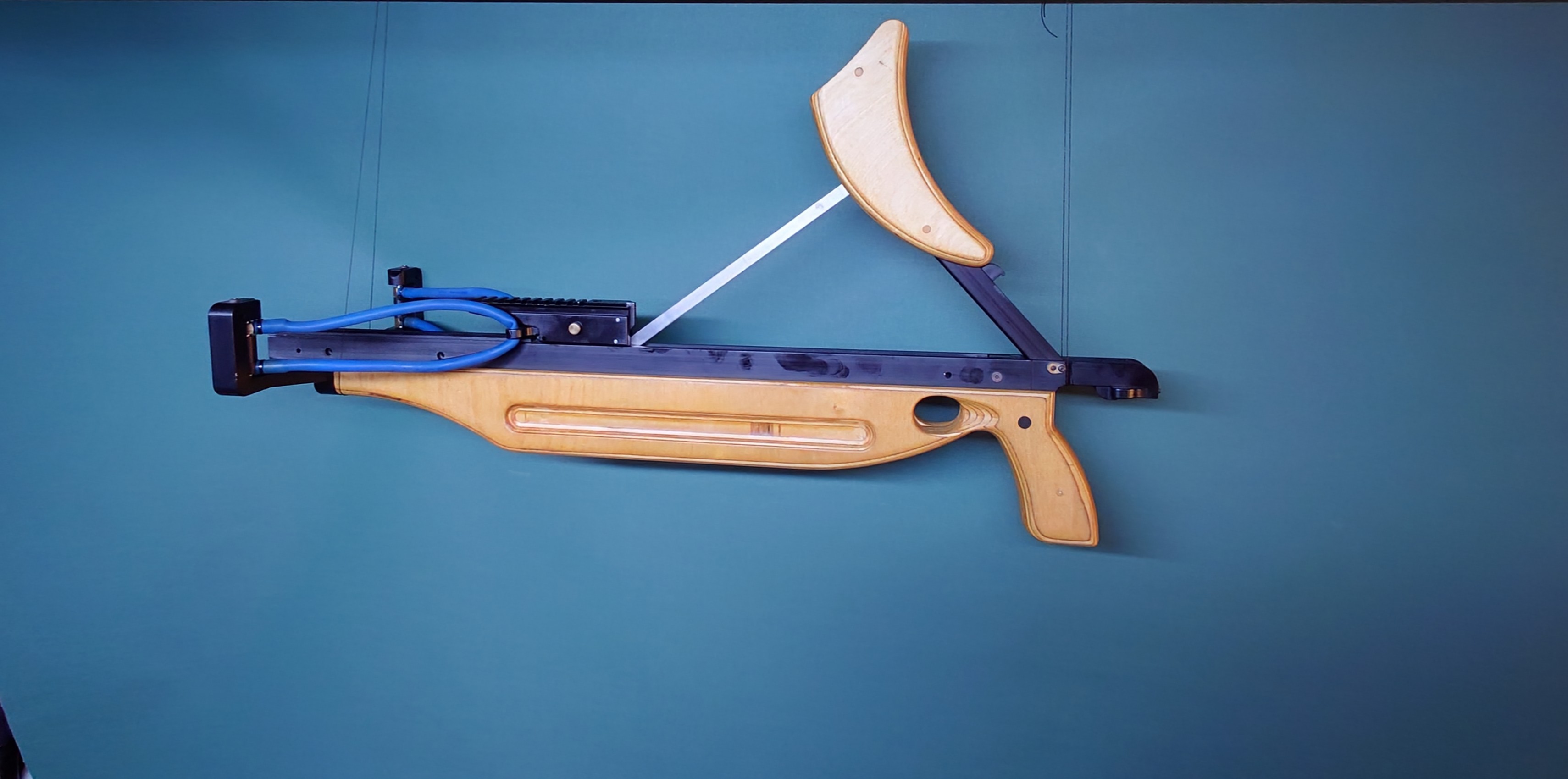GET-Designs.uk
Designing Air Weapons since 1994 in the heart of England
RFD No 55/00000002542
* 3D Models.
* CNC Produced, Prototypes.
* Detailed production drawings.
* Assistance with manufacturing techniques and tooling.
* Ongoing Technical assistance and product development.


Graham Trim said on the 2024-10-10 16:01:47
Velociraptor project
Whilst we normally concentrate on Air Weapons.
This project was started over ten years ago and after several tests had been carried out, we considered it a to be a failure.
However, for the sake of interest, I will now explain in more detail what happened and a recent re-development.
The original idea, was to produce a simple type of self cocking crossbow, powered by an uprated catapult type mechanism
that would fire 12inch crossbow bolts and 3/8” steel balls for target practice.
Design Features
The unique style stock, was produced by CNC cutting individual pieces of 12 mm slow grown birch ply and glue laminating them together to produce a stable simple housing for the cocking mechanism.
The trigger, is our interpretation of a rolling block adapted for rifle use. However, in this form it is only single pull, but there is a simple push on, and off safety catch button.
The power source, consists of an alloy yoke which is 250mm wide at the extremities, housing two vertical shafts on which are fitted four banjo units, rotating on needle roller bearings to support the ends of the tubular rubber power bands that are attached to each end of the projectile carrier. In effect cocking this unit is equivalent to pulling back two catapults together which is made much easier with the built in leverage system.
The projectile carrier, has a 9.5 mm diameter recess to accept the steel ball or bolt end. There is a strategically placed neodymium magnet under the flight rail to keep the ball from falling out before it is fired. There is another magnet placed at the front end of the flight rail to co-inside with a steel collar on the bolt to keep it in place if used as an alternative. The advantage of using magnets is that the projectile is secure when stationary and totally free to move when fired after only a few millimetres of travel.
Operation
To cock this weapon, the locking catch is released, and the but-stock lifted which moves the flight rail,
including the trigger and scope mount forward so that the carrier can be locked into the trigger jaws as shown.
When the carrier is pushed home, the trigger then sets, and the safety catch can be applied before the cocking leaver is operated by bringing the but-stock back to its rest position,
where it is automatically locked into place for safety by the self-locking catch.
The weapon, is now primed and ready for a ball or bolt to be fitted as required, before taking aim and releasing the safety catch to fire.
Pictured here with dummy blunt bolt in place.
Limitations
This first version, of this weapon was rubber powered which whist it appeared to be a good idea at the time and has been used in many places on the internet, particularly on YouTube.
However, there are several limitations with this system.
Rubber, which although very stretchy has a fairly slow rate of return, when compared to other spring type systems such as conventional bows etc.
Rubber, when stretched the molecules heat up and if released quickly will return faster than if the system is allowed to cool for a few minutes before firing.
It is essential, that both rubber loops are identical in size or there will be accuracy issues, and the projectile will veer left or right.
It is important, to make sure that the rubber is not damaged and if one loop needs replacing, it is imperative that both are changed to maintain accuracy.
Test results
When testing, it appeared that this rubber system using hollow urethane tubing and a total overall stretched length of 460mm produced a maximum round figure speed of 200 ft/min. This was achieved using the steel balls and firing immediately after cocking, if we let the rubber settle for a few minutes it dropped to 180 ft/min. The steel balls weigh 54.2 grains and therefore the resultant power was disappointing, at between 4.8 and 3.9 ft/lbs of energy. Our light weight 12-inch bolt weighed 285 grains and achieved speeds of between 160 and 150 ft/sec or between 16.2 and 14.2 ft/lbs of energy. We did try using flat rubber bands but whilst the ball went slightly faster by around 20 ft/second the bolt went noticeably, much slower. Whilst the power produced with the bolt is more than a UK legal 12ft/lb Air Rifle, its rate of drop was unsuitable from a practical point of view. For these reasons this project was shelved.
Forward to August 2024
One evening, whilst talking to friends we were discussing medieval crossbows and how much they were feared by those who came under fire from them. This caused me to do some further research on the type of bolt used. Firstly, whilst there are so many shapes used for different purposes, such as hunting different quarries, the striking thing for me was that the weight of them varied from 1.5 to 3 ounces and the shaft could be anything up to ¾ of an inch (19mm) in diameter, most being around 5/8 (16mm). This is 650 to 1300 grains, and the shafts were often barrel shaped so that they only touched the flight groove at the centre position to reduce friction. (yes, we know from the complexity of some ancient bolt designs, that the best of our ancestral, shooters did consider friction back in the Middle Ages!!!) Often the shafts were made from hard wood such as Oak which helped to give strength and substance because the bows used had a short and a very heavy draw weight. The flights were made from parchment or fine leather and could be 2 or 3 in number, but usually set like the wings and tail of an aeroplane unlike the 3 x 120-degree spaced system currently used. It appears, that they were set straight on the shaft so that it did not spin, and one flight was not put down a groove as almost everyone does today. The points were steel and usually forged to shape.
The Bolt
Having absorbed all this information, I decided to use it as a basis for producing a 12-inch version of a modern medieval type of bolt just to see how scary it would be to look at. However, since I wanted to be able to try it without the medieval style broad head point, I used a modern screw thread system and because I didn’t have a fletching jig that would do the 90-degree wing type configuration used the modern 3 x 120-degree system. However, I did set them longitudinal to the shaft so that it would not spin. I had some ½ inch Oak Dowel rod which I used for the main shaft and since it was normal to reduce the knock end to fit into the rolling block trigger block, I turned it down to .375 inches (9.5mm). With a 150 grain point the resultant bolt has an all-up weight of 675 grains.
I must admit, this short fat bolt with long flights and a broad head point does look very scary as a weapon,
but I suppose an ancient long bow arrow with war head, fired in volleys would frighten anyone on the receiving end too.
Back to Velociraptor
Having produced this bolt, and remembering that my original idea over ten years ago was to use heavy type bolts. I decided to dig it out of storage and give it a try, but I must admit the results were astonishing. The 150 grain broad head was exchanged for a 150-grain field point and achieved speeds of between 140 and 150 ft/sec which equates to between 29 to 34 ft/lbs of energy. This was surprising as I expected it to be much slower. It appears that whilst the heavy rubber tube does not go very fast, it will carry heavier weights for the same amount of input.
This is a Slow Motion Video of the new Bolt being fired.
However, being slow moving and heavy it does pack quite a punch on impact and as can be seen from the slowed down video it flies quite true too.
The sound of the impact is quite pronounced but out of sync due to the slow-motion effect and a certain amount of echo from the surounding buildings etc.
Simple Conclusion
Whist this weapon, will fire heavy bolts effectively over relatively short distances, for 3/8” steel balls it appears that a longer draw length and lighter rubber driving bands would be required.
Thus, rubber powered spear guns use heavy rubber, and catapults use a lighter form of the material but with a much longer pull length.
Velociraptor Mk2 Design Note
For higher velocities, the Velociraptor Mk2 design, listed on this site is powered by a small lightweight pneumatic version of our cantilevered crossbow limb system.
However, the draw length is reduced to improve the efficiency of the cocking mechanism and to suit the characteristics of this new and unique type of bow.
If this blog interested you, Click on this link to see our unique range of Air Weapons
Shop Sales Note
Whilst we are mainly here to sell designs of our products to industry and normally only really produce one off prototypes,
we did recently produce a small batch of Nimrod rifles for sale to private individuals. Each one hand made to the same standard as our prototypes
and there is currently one .177 rifle in stock. If anyone is interested, please get in touch via the contacts page.

More in the series ...
From Humble Beginnings
The story behind the making of my first ever PCP.
Whirlwind CNC Rifling Machine
Reaper Development Trail
Paradigm Development part 3
Paradigm Development part 2
Paradigm Development part 1
Twin Opposing Piston Spring Rifles Preface
3D Printing And Air Weapon Development
Nimrod Air Gun 2024
Innovate to Thrive
Fox Rifle Dynasty
Observations regarding the Webley MkII Service Rifle



